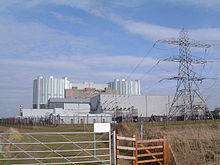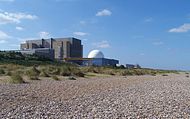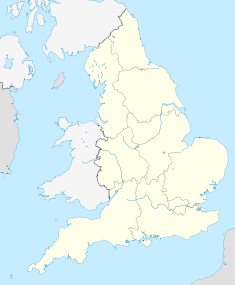- Oldbury Nuclear Power Station
-
Oldbury Nuclear Power Station 
Location of Oldbury Nuclear Power Station Country England Location Gloucestershire Coordinates 51°38′56″N 2°34′15″W / 51.648889°N 2.570833°WCoordinates: 51°38′56″N 2°34′15″W / 51.648889°N 2.570833°W Commission date 1967 Decommission date 2012 Owner(s) Nuclear Decommissioning Authority Operator(s) Magnox Limited Reactor information Reactors operational 1 × 217 MWe (net), (230 MWe gross) Power generation information Installed capacity 217 MWe (net) Maximum capacity 600 MWe (design, net) Oldbury nuclear power station is a nuclear power station located on the south bank of the River Severn close to the village of Oldbury-on-Severn in South Gloucestershire, England. It is operated by Magnox North Limited, on behalf of the Nuclear Decommissioning Authority (NDA). Oldbury is one of four stations located close to the mouth of the River Severn and the Bristol Channel, the others being Berkeley, Hinkley Point A and Hinkley Point B.
Contents
History
Opened in 1967, it had two Magnox reactors producing 424 megawatts (MWe) in total[1][2] – enough electricity on a typical day to serve an urban area twice the size of Bristol. Reactor 1 went critical on 18th September 1967 and first generated electricity on 9th November 1967, Reactor 2 started generating electricity in April of 1968.[3]
The construction was undertaken by a consortium known as The Nuclear Power Group ('TNPG').[4] The reactors were supplied by TNPG and the turbines by AEI and C. A. Parsons & Co.[2] The main civil engineering contractor was Alfred McAlpine.[2] Construction on site began in 1961.[3]
Oldbury was the first nuclear power station in the UK to use prestressed concrete pressure vessels, earlier Magnox reactors having used steel pressure vessels more suited to smaller reactors.[5]
The design net power output of the station was 600 MWe, but due to steel corrosion problems from the hot carbon dioxide coolant within the reactor, operating temperature had to be reduced soon after operation started causing a large drop in power output. Initially power output was set at 424 MWe, dropping to 400MWe by 1973. Then as remedial measures were adopted power was progressively increased to 434 MWe by 1983 with a gas outlet temperature of 365°C, compared to the 412°C design temperature, which was maintained as the normal operational output.[6][1]
The station was originally to be decommissioned at the end of 2008, however the reactors continued use has been licensed in various stages for an additional two and a half years in the case of reactor 2 (now shutdown) and 4 years for reactor 1. [7][8][9][10]
Reactor 2 ceased operating permanently on 30 June 2011.[11] Reactor 1 will cease operating from February 2012.[12]
Incidents
On 30 May 2007, only a few days after reopening after safety checks, the power station was shut down as part of standard emergency procedure when a fire broke out on one of the generator transformer HV bushings. No-one was injured in the fire and no radiation was released. Information suggests an insulator overheated causing it to fail. Minor damage ensued resulting in a standard shutdown. This area is a significant distance from any reactor or material that could be considered any risk. All emergency procedures were commenced and by 11:30am the situation was stabilised.[13][14] The power station resumed production for a few days in June then shut down again. Production eventually resumed on 24 August 2007, at which point it had only produced electricity for eight days since August 2006.[15]
On 17 Mar 2011 at 10:40, Reactor 2 was automatically shut down after an electrical problem.[16] Magnox stated that workers had been carrying out routine maintenance when a small relay overheated (this failure caused the turbine to shut down). Their spokesman went on to say "Because the turbine tripped the steam produced in the boilers couldn’t be sent to the turbine as it would normally and so was released through relief valves on top of the building." and "To reduce the amount of steam being produced, and in accordance with expectations, the reactor automatically tripped and was safely shut down."[17]
On 14 July 2011, Reactor 1 was automatically shut down after 'problems with the refuelling machinery.' Large plumes of steam could be seen rising from the power station, concerning near-by residents. The incident came a week after the number 2 reactor was permanently shut down after its 43-year life because it had 'reached the end of its operational life'. Number 1 reactor is expected to be back on line within three weeks of the incident and to continue operating until the end of 2012.[18]
The power station silt lagoons
The silt lagoons at Oldbury power station are used as a high tide roosting site by birds which feed on the Severn Estuary. Between 1979 and 2005, 199 bird species were recorded at the site.[19] This included a number of vagrants: a Green-winged Teal in January 2001, a Ring-necked Duck in April and May 2000, a Black-winged Stilt in May 1997, a Kentish Plover in August 1993, a Semipalmated Sandpiper in August 1990, a Temminck's Stint in April 1984, a Pectoral Sandpiper in September 1989, a Broad-billed Sandpiper in August 1983, a Ring-billed Gull in October 1994, and a Richard's Pipit in October 1996.[19]
Future nuclear plant plans
Horizon Nuclear Power, an E.ON and RWE joint venture, announced in 2009 intentions to install up to 3,300 MWe of new nuclear plant at Oldbury. Horizon is considering building up to either two 1,650 MWe Areva EPR reactors, or three 1,100 MWe Westinghouse AP1000 reactors. As the Severn estuary water supply would be inadequate to cool these larger reactors, cooling towers would be built.[20][21]
On 18 October 2010 the British government announced that Oldbury was one of the eight sites it considered suitable for future nuclear power stations.[22]
In popular culture
Oldbury was used as a filming location for the Doctor Who serial, The Hand of Fear. Filming at Oldbury took place in 1976. On one occasion, long running music show Top of the Pops was even filmed inside one of the reactor buildings.[3] The power station also appeared in several episodes of Blake's Seven [1].
See also
- Nuclear power in the United Kingdom
- Energy policy of the United Kingdom
- Energy use and conservation in the United Kingdom
References
- ^ a b "United Kingdom of Great Britain and Northern Ireland: Nuclear Power Reactors". PRIS database. International Atomic Energy Agency. 22 May 2010. http://www.iaea.org/cgi-bin/db.page.pl/pris.powrea.htm?country=GB. Retrieved 2010-05-22.
- ^ a b c Nuclear Power Plants in the UK
- ^ a b c http://www.mythornbury.co.uk/oldbury_power_station
- ^ The UK Magnox and AGR Power Station Projects
- ^ Walter C. Patterson (1985). Going Critical: An Unofficial History of British Nuclear Power. Paladin. ISBN 0-586-08516-5. http://www.waltpatterson.org/goingcritical.pdf. Retrieved 2009-06-12.
- ^ Nuclear Installations Inspectorate (September 2000). Report by HM Nuclear Installations Inspectorate on the results of Magnox Long Term Safety Reviews (LTSRs) and Periodic Safety Reviews (PSRs) (Report). Health and Safety Executive. p. 27 (Table 3). http://www.hse.gov.uk/nuclear/magnox.pdf. Retrieved 2010-03-21.
- ^ "Oldbury powers on into 2009". NDA. 18 December 2008. http://www.nda.gov.uk/news/oldbury-power.cfm. Retrieved 2011-07-21.
- ^ Schaps, Karolin (23 August 2010). "Magnox aims to run UK Oldbury reactor until mid-2012". Reuters. http://uk.reuters.com/article/2010/08/23/britain-nuclear-oldbury-idUKLDE67M0TE20100823. Retrieved 2011-07-21.
- ^ Schaps, Karolin (9 February 2011). "Oldbury 2 nuclear unit can run until June - Magnox". Reuters. http://uk.reuters.com/article/2011/02/09/uk-britain-nuclear-oldbury-idUKTRE7182A920110209. Retrieved 2011-07-21.
- ^ "Oldbury 1 nuclear reactor gets 2012 extension". Reuters. 22 June 2011. http://uk.reuters.com/article/2011/06/22/uk-energy-uk-nuclear-idUKTRE75L3LJ20110622. Retrieved 2011-07-21.
- ^ "Oldbury nuclear power station Reactor 1 shut down". BBC. 14 July 2011. http://www.bbc.co.uk/news/uk-england-bristol-14161129. Retrieved 2011-07-14.
- ^ "Oldbury Power Station to stop generating electricity". BBC. 21 October 2011. http://www.bbc.co.uk/news/uk-england-bristol-15408460. Retrieved 21 October 2011.
- ^ "Nuclear reactor set to re-start". BBC News. 18 May 2007. http://news.bbc.co.uk/1/hi/england/bristol/6669703.stm. Retrieved 2007-05-30.
- ^ "Fire closes nuclear power station". BBC News. 30 May 2007. http://news.bbc.co.uk/1/hi/england/bristol/6705243.stm. Retrieved 2007-05-30.
- ^ "Power is back on at nuclear plant". BBC News. 24 August 2007. http://news.bbc.co.uk/1/hi/england/bristol/6962494.stm. Retrieved 2007-08-24.
- ^ Schaps, Karolin (17 March 2011). "Oldbury 2 nuclear unit shuts after electrical problem". Reuters. http://uk.reuters.com/article/2011/03/17/uk-oldbury-2-nuclear-unit-shuts-after-el-idUKTRE72G44M20110317. Retrieved 2011-07-01.
- ^ "Nuclear bosses give assurances after steam is seen coming from reactor at Oldbury". gazetteseries.co.uk. 24 March 2011. http://www.gazetteseries.co.uk/news/8926487.print/. Retrieved 2011-07-01.
- ^ "Oldbury nuclear power station reactor 1 shut down". BBC.co.uk. 14 July 2011. http://www.bbc.co.uk/news/uk-england-bristol-14161129. Retrieved 2011-07-01.
- ^ a b Middleton, A. J., D. H. Payne and J. D. R. Vernon (2007) The Birds of Olbury Power Station Silt Lagoons Bristol Ornithology 28: 3-40
- ^ James Murray (30 April 2009). "RWE/E.ON and EDF win nuclear auction". BusinessGreen. http://www.businessgreen.com/bg/news/1803109/rwe-eon-edf-win-nuclear-auction. Retrieved 11 November 2010.
- ^ "FAQs: OLDBURY". Horizon Nuclear Power. http://www.horizonnuclearpower.com/faq_oldbury.php. Retrieved 11 November 2010.
- ^ "Nuclear power: Eight sites identified for future plants". BBC News (BBC). 18 October 2010. http://www.bbc.co.uk/news/uk-politics-11564152. Retrieved 18 October 2010.
External links
- British Nuclear Group - Oldbury
- Nuclear Decommissioning Authority - Oldbury
- Oldbury Site Stakeholder Group
Electricity generation in South West England Power stations ClosedCarn Brea · Castle Meads · East Yelland · Exeter · Hayle · Newton Abbot · Plymouth · Poole · Portishead A + BActiveClosedPrincetownProposed/FutureClosedFutureActiveHinkley Point B · OldburyClosedProposed/FutureHinkley Point C · Oldbury BClosedActiveProposed/Future
Organisations Ecogen · Ecotricity · Geothermal Engineering Ltd. · Good Energy · Infralec · Marine Current Turbines · Mendip Power Group · npower · Nuclear Electric · Ovo Energy · Pre-nationalisation electric power companies · South Somerset Hydropower Group · SWEB Energy · Western Power Distribution · Wind Prospect Nuclear power in the United KingdomEnergy in the United Kingdom · Nuclear power
Nuclear power in the United KingdomEnergy in the United Kingdom · Nuclear powerCompanies and
organisationsBNFL (British Nuclear Fuels plc) · Civil Nuclear Constabulary · British Nuclear Group (BNG) · EDF Energy · Horizon Nuclear Power · Magnox Ltd · Nuclear Decommissioning Authority (NDA) · National Nuclear Laboratory · Nuclear Liabilities Fund · NuGeneration · Office for Nuclear Regulation · United Kingdom Atomic Energy Authority (UKAEA)
Reactors ActiveOldbury · WylfaClosedBerkeley · Bradwell · Calder Hall · Chapelcross · Dungeness A · Hinkley Point A · Hunterston A · Sizewell A · TrawsfynyddSizewell B | DounreayNon-reactor sites Capenhurst (uranium enrichment) · Sellafield (reprocessing) · Springfields, Salwick (fuel manufacture) · Winfrith (research and development)Other Anti-nuclear movement in the United Kingdom · Franco-British Nuclear Forum · Nuclear power in Scotland · Tier 1 – UK Nuclear Site Management & Licensing
Categories:- Nuclear power stations in England
- Buildings and structures in South Gloucestershire
- Power stations in South West England
Wikimedia Foundation. 2010.

